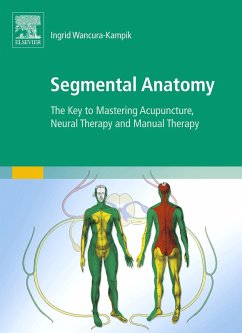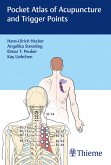Segmental Anatomy (eBook, ePUB)
The Key to Mastering Acupuncture, Neural Therapy, and Manual Therapy


Alle Infos zum eBook verschenken

Segmental Anatomy (eBook, ePUB)
The Key to Mastering Acupuncture, Neural Therapy, and Manual Therapy
- Format: ePub
- Merkliste
- Auf die Merkliste
- Bewerten Bewerten
- Teilen
- Produkt teilen
- Produkterinnerung
- Produkterinnerung

Hier können Sie sich einloggen

Bitte loggen Sie sich zunächst in Ihr Kundenkonto ein oder registrieren Sie sich bei bücher.de, um das eBook-Abo tolino select nutzen zu können.
In Segmental Anatomy the correlations between spinal nerves and segments in skin, musclar system and bones are formidably illustrated and written. The projection areas of internal organs on the body surface area are deduced from the anatomy of the nervous system.
These correlations between spinal nerves and the periphery of the body explain how acupuncture, neural, and manual therapies take effect.
Great accessibility through:
Full colour images | Drawings that depict the correlations in detail | Clearly structured layout facilitating the reading of this complex subject
- Geräte: eReader
- mit Kopierschutz
- eBook Hilfe
![Chinesische Bauchakupunktur (eBook, ePUB) Chinesische Bauchakupunktur (eBook, ePUB)]() Yuan HepingChinesische Bauchakupunktur (eBook, ePUB)27,99 €
Yuan HepingChinesische Bauchakupunktur (eBook, ePUB)27,99 €![Leitbahnen der Akupunktur (eBook, ePUB) Leitbahnen der Akupunktur (eBook, ePUB)]() Leitbahnen der Akupunktur (eBook, ePUB)129,99 €
Leitbahnen der Akupunktur (eBook, ePUB)129,99 €![Kursbuch Naturheilverfahren (eBook, ePUB) Kursbuch Naturheilverfahren (eBook, ePUB)]() Kursbuch Naturheilverfahren (eBook, ePUB)54,99 €
Kursbuch Naturheilverfahren (eBook, ePUB)54,99 €- -26%11
![Pocket Atlas of Acupuncture and Trigger Points (eBook, ePUB) Pocket Atlas of Acupuncture and Trigger Points (eBook, ePUB)]() Pocket Atlas of Acupuncture and Trigger Points (eBook, ePUB)40,95 €
Pocket Atlas of Acupuncture and Trigger Points (eBook, ePUB)40,95 € ![Manipulative Therapien der Integrativen Medizin: Akupunktur, Akupressur, Neuraltherapie (eBook, ePUB) Manipulative Therapien der Integrativen Medizin: Akupunktur, Akupressur, Neuraltherapie (eBook, ePUB)]() Hubertus R. HommelManipulative Therapien der Integrativen Medizin: Akupunktur, Akupressur, Neuraltherapie (eBook, ePUB)15,99 €
Hubertus R. HommelManipulative Therapien der Integrativen Medizin: Akupunktur, Akupressur, Neuraltherapie (eBook, ePUB)15,99 €![Die machbaren Wunder (eBook, ePUB) Die machbaren Wunder (eBook, ePUB)]() Manfred KöhnlechnerDie machbaren Wunder (eBook, ePUB)10,99 €
Manfred KöhnlechnerDie machbaren Wunder (eBook, ePUB)10,99 €![Anatomie und Physiologie (eBook, ePUB) Anatomie und Physiologie (eBook, ePUB)]() Marianne SchoppmeyerAnatomie und Physiologie (eBook, ePUB)31,99 €
Marianne SchoppmeyerAnatomie und Physiologie (eBook, ePUB)31,99 €-
-
-
These correlations between spinal nerves and the periphery of the body explain how acupuncture, neural, and manual therapies take effect.
Great accessibility through:
- Full colour images
- Drawings that depict the correlations in detail
- Clearly structured layout facilitating the reading of this complex subject
Dieser Download kann aus rechtlichen Gründen nur mit Rechnungsadresse in A, B, BG, CY, CZ, D, DK, EW, E, FIN, F, GR, HR, H, IRL, I, LT, L, LR, M, NL, PL, P, R, S, SLO, SK ausgeliefert werden.
- Produktdetails
- Verlag: Elsevier Health Science
- Seitenzahl: 384
- Erscheinungstermin: 4. Oktober 2012
- Englisch
- ISBN-13: 9783437591747
- Artikelnr.: 43902956
- Verlag: Elsevier Health Science
- Seitenzahl: 384
- Erscheinungstermin: 4. Oktober 2012
- Englisch
- ISBN-13: 9783437591747
- Artikelnr.: 43902956
- Herstellerkennzeichnung Die Herstellerinformationen sind derzeit nicht verfügbar.
MD for general medicine, has a private practice in Vienna for over forty years now. She has been studying the theory of segments since 1965 and acupuncture since 1970, including studies at the University of Traditional Chinese Medicine in Beijing.
Dr. Wancura, who has also studied the Chinese language and worked in two acupuncture surgeries in Beijing, was the first to analyse Chinese acupuncture from the perspective of western science and segment theory.
She has published several books on the topic, taught and lectured at several universities and is president emeritus as well as honorary member of several acupuncture societies.
Segmentation and Metamerism 1
What is a Segment? 1
The Significance of Segments 7
2
The Role of the Peripheral Spinal Nervous System in Segmentation 1
The Spinal Nerves 4
The Branches of the Spinal Nerves 15
The Three Spinal Nerve Branches As the Basis of the Threefold Longitudinal Division of the Body Surface 18
The Branches of the Spinal Nerves in Detail 32
The Dorsal Branches of the Spinal Nerves 32
The Dorsal Branches in Psychosomatic Medicine and Evolution 37
The Ventral and Lateral Spinal Nerve Branches and Plexuses 41
Plexus Formation from the Point of View of Segmental Anatomy 42
The Individual Plexuses 47
The Pre- and Postaxial Lines, Basis of the Meridian-"Lines" 70
3
The Role of the Peripheral Autonomic Nervous System in Segmental Theory 1
Anatomy 2
The Peripheral Sympathetic Nervous System and Its Role in Segmental Theory 4
The Origins of the Sympathetic Nervous System 5
Sympathetic Innervation of the Limbs 6
Sympathetic Effects on the Dilator Pupillae Muscle and on the Effector Organs of the Integument 7
Sympathetic Supply to the Head, Neck, and Limbs 10
The Efferent Sympathetic Nerves 12
The Afferent Sympathetic Nerve Pathways 33
The Large Sympathetic Ganglia and Their Projections onto the Skin 38
The Peripheral Parasympathetic Nervous System and Its Role in Segmental Theory 46
4
The Dermatomes 1
Radicular Innervation of the Integument 1
Clinical Relevance 2
Parts of a Dermatome 4
The Sensory and Autonomic-Motoric Dermatomes 6
Sensory Dermatomes 6
Autonomic-Motoric Dermatomes 8
Physiological Hyperesthesia 9
The Maximum Points of the Dermatomes 9
The Maximum Areas of the Dermatomes 13
The Hiatus Lines 14
Individual Dermatome Groups, Extent and Shape, Interactions, and "Autonomic Facial Expression" 17
Dermatomes of the Head and Neck 17
Dermatomes of the Trunk T1 to T12 25
The Lumbar and Sacral Dermatomes 29
Dermatoses and Segmentation 30
5
The Myotomes 1
Radicular Innervation of the Muscles 1
Metameric Order of the Myotomes 2
Herringham's Rules of Location and Distribution of Myotomes in the Muscles 3
The Muscles of the Upper and Lower Limbs and Their Corresponding Myotomes 6
The Individual Myotome Groups 7
The Cervical Myotomes 7
The Thoracic Myotomes (T 1 to T 12) 24
The Lumbo-Sacral Myotomes 34
6
The Sclerotomes 1
Radicular Innervation of the Bones 1
The Spinal Column and Its Segmental Relations 4
The Individual Sclerotomes 6
The Sclerotomes of the Upper Limb and the Shoulder Girdle 6
The Sclerotomes of the Lower Limb and the Pelvis 8
7
The Enterotomes 1
"Transformation" of Internal Organs into Enterotomes 4
8
Conduction of Impulses Betweeen Segments* 1
Multisynaptic, Proprioceptive, and Viscerogenic Reflexes 1
9
Referred Pain 1
Pain Projected to the Body Surface in Visceral Disease 1
Projected Symptoms 4
On the Location of Projected Symptoms 9
Clinical Significance of Projected Symptoms 9
Algetic Symptoms 10
Hyperalgesia and Hyperesthesia of the Cutis and Subcutis (Head Zones) 12
Hyperalgia of Muscles and Tendons (Mackenzie Zones) 14
Comparison of Pseudoradicular Syndromes, e.g., Radiation of Pain from a Joint Capsule (Fig. 9.4) and Referred Pain (Fig. 9.3) 18
Autonomic-Reflexive Symptoms 21
Autonomic Effects in the Integument 22
Effects on the Head 27
Effects in the Shoulder 35
Asymmetry of Posture and Movement 36
Reflexive and Algetic Spinal Column Syndromes 37
Asymmetry of Proprioceptive and Multisynaptic Reflexes 38
Autonomic Organ Reflexes (Viscero-Visceral-Reflexes) 40
10
The Visceral Organs-the Enterotomes from the Viewpoint of Segmental Anatomy 1
Interactions and Projectional Phenomena 1
The Heart: Algetic and Autonomic-Reflexive Areas of Projection 2
Lungs a
Segmentation and Metamerism 1
What is a Segment? 1
The Significance of Segments 7
2
The Role of the Peripheral Spinal Nervous System in Segmentation 1
The Spinal Nerves 4
The Branches of the Spinal Nerves 15
The Three Spinal Nerve Branches As the Basis of the Threefold Longitudinal Division of the Body Surface 18
The Branches of the Spinal Nerves in Detail 32
The Dorsal Branches of the Spinal Nerves 32
The Dorsal Branches in Psychosomatic Medicine and Evolution 37
The Ventral and Lateral Spinal Nerve Branches and Plexuses 41
Plexus Formation from the Point of View of Segmental Anatomy 42
The Individual Plexuses 47
The Pre- and Postaxial Lines, Basis of the Meridian-"Lines" 70
3
The Role of the Peripheral Autonomic Nervous System in Segmental Theory 1
Anatomy 2
The Peripheral Sympathetic Nervous System and Its Role in Segmental Theory 4
The Origins of the Sympathetic Nervous System 5
Sympathetic Innervation of the Limbs 6
Sympathetic Effects on the Dilator Pupillae Muscle and on the Effector Organs of the Integument 7
Sympathetic Supply to the Head, Neck, and Limbs 10
The Efferent Sympathetic Nerves 12
The Afferent Sympathetic Nerve Pathways 33
The Large Sympathetic Ganglia and Their Projections onto the Skin 38
The Peripheral Parasympathetic Nervous System and Its Role in Segmental Theory 46
4
The Dermatomes 1
Radicular Innervation of the Integument 1
Clinical Relevance 2
Parts of a Dermatome 4
The Sensory and Autonomic-Motoric Dermatomes 6
Sensory Dermatomes 6
Autonomic-Motoric Dermatomes 8
Physiological Hyperesthesia 9
The Maximum Points of the Dermatomes 9
The Maximum Areas of the Dermatomes 13
The Hiatus Lines 14
Individual Dermatome Groups, Extent and Shape, Interactions, and "Autonomic Facial Expression" 17
Dermatomes of the Head and Neck 17
Dermatomes of the Trunk T1 to T12 25
The Lumbar and Sacral Dermatomes 29
Dermatoses and Segmentation 30
5
The Myotomes 1
Radicular Innervation of the Muscles 1
Metameric Order of the Myotomes 2
Herringham's Rules of Location and Distribution of Myotomes in the Muscles 3
The Muscles of the Upper and Lower Limbs and Their Corresponding Myotomes 6
The Individual Myotome Groups 7
The Cervical Myotomes 7
The Thoracic Myotomes (T 1 to T 12) 24
The Lumbo-Sacral Myotomes 34
6
The Sclerotomes 1
Radicular Innervation of the Bones 1
The Spinal Column and Its Segmental Relations 4
The Individual Sclerotomes 6
The Sclerotomes of the Upper Limb and the Shoulder Girdle 6
The Sclerotomes of the Lower Limb and the Pelvis 8
7
The Enterotomes 1
"Transformation" of Internal Organs into Enterotomes 4
8
Conduction of Impulses Betweeen Segments* 1
Multisynaptic, Proprioceptive, and Viscerogenic Reflexes 1
9
Referred Pain 1
Pain Projected to the Body Surface in Visceral Disease 1
Projected Symptoms 4
On the Location of Projected Symptoms 9
Clinical Significance of Projected Symptoms 9
Algetic Symptoms 10
Hyperalgesia and Hyperesthesia of the Cutis and Subcutis (Head Zones) 12
Hyperalgia of Muscles and Tendons (Mackenzie Zones) 14
Comparison of Pseudoradicular Syndromes, e.g., Radiation of Pain from a Joint Capsule (Fig. 9.4) and Referred Pain (Fig. 9.3) 18
Autonomic-Reflexive Symptoms 21
Autonomic Effects in the Integument 22
Effects on the Head 27
Effects in the Shoulder 35
Asymmetry of Posture and Movement 36
Reflexive and Algetic Spinal Column Syndromes 37
Asymmetry of Proprioceptive and Multisynaptic Reflexes 38
Autonomic Organ Reflexes (Viscero-Visceral-Reflexes) 40
10
The Visceral Organs-the Enterotomes from the Viewpoint of Segmental Anatomy 1
Interactions and Projectional Phenomena 1
The Heart: Algetic and Autonomic-Reflexive Areas of Projection 2
Lungs a







